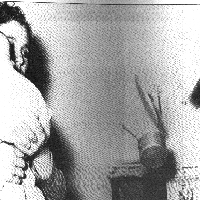
"Poltergeist" comes from the German words poltern, "to knock" and "rumbling
spirit". The history of poltergeists can be traced as far back as ancient Roman times. Reports of poltergeist disturbances
cite loud noises, lights, smells, physical and sexual assault, telephones ringing, and in general create unexplained disturbances.
Some people believe that poltergeist activity is caused by an unconscious form of telekinesis.
Teens - Puberty
Poltergeist activity usually takes place when a particular individual
is present - usually young teenagers at puberty who has emotional problems. A poltergeist is often thought of as a negative
spirit attracted to these teenagers. Due to hormonal and emotional changes in the teenager's body, negative energy may be
thrust outwardly sometimes moving or destroying objects telekinetically. Young teens seek to develop telekinetic abilities. Poltergeist activity can cease as suddenly as it started. It
can last anywhere from a few hours to a few years.
From Wikipedia
A poltergeist (German for rumbling ghost) is widely believed to be
an invisible ghost that interacts with others by moving and influencing inanimate objects. Stories featuring poltergeists
typically focus heavily on raps, thumps, knocks, footsteps, and bed-shaking, all without a discernable point of origin. Many
stories detail objects being thrown about the room, furniture being moved, and even people being levitated. A few poltergeists
have even been known to speak (The Bell Witch, 1817; Gef, the Talking Mongoose, 1931). Most classic poltergeist stories originate
in England, though the word itself is German.
Poltergeist phenomena is a focus of study within parapsychology (a
discipline which does not have wide acceptance within the mainstream scientific community). Parapsychologists define poltergeist
activity as a type of uncontrolled psychokinesis. Recurrent Spontaneous Psychokinesis (RSPK) is a phrase suggested by parapsychologist
William G. Roll to denote poltergeist phenomena.
Poltergeist activity tends to occur around a single person called an
agent or a focus (typically a prepubescent female). Almost seventy years of research by the Rhine Research Center (Raleigh-Durham,
NC USA) has led to the hypothesis among parapsychologists that the "poltergeist effect" is a form of psychokinesis generated
by a living human mind (that of the agent). According to researchers at the Rhine Center, the "poltergeist effect" is the
outward manifestation of psychological trauma.
Skeptics believe that the phenomena are hoaxes perpetrated by the agent.
Indeed, many poltergeist agents have been caught by investigators in the act of throwing objects. A few of them later confessed
to faking. However, parapsychologists investigating poltergeists think that most occurences are real, and the agents cheat
only when they are subsequently caught cheating. The longevity and consistency between poltergeist stories (the earliest one
details the raining of stones and bed shaking in ancient Egypt) has left the matter open for debate within the parapsychology
community.
Another version of the poltergeist is the "wrath version." When a person
dies in a powerful rage at the time of death, that person is believed by some to come back to fulfill that vengeance. In some
cases, the vengeance is too strong to let go or forgive, and the metaphysical ghost becomes a poltergeist, in which the newly
formed ghost can affect solid objects, and in some cases are deadly. According to yet another opinion, ghosts and poltergeists
are "recordings." When there is a powerful emotion, sometimes at death and sometimes not, a recording is believed to be embedded
into the fabric of time, and this recording will continue to play over and over again until the energy embedded disperses.
Some people theorize that poltergeists are caused by the Hutchison
effect.William Roll and Harry Price are perhaps two of the most famous poltergeist investigators in the annals of parapsychology.
Harry Price investigated Borley Rectory which is widely regarded as "the most haunted house in England."
Famous alleged poltergeist infestations
Although poltergeist stories date back to the first century, most evidence
to support the existence of poltergeists is anecdotal. Indeed, many of the stories below have several versions and/or inconsistencies.
The Bell Witch (1817)
The Haunting of The Fox sisters (1848) - arguably one of the most
famous, as it started the Spiritualism movement.
The Borley Rectory phenomena (1929)
The Rosenheim (Bavaria) Poltergeist (1967)
The Enfield Poltergeist (1977)
Poltergeists in fiction Both the name and concept of the
poltergeist became famous to modern audiences by the Poltergeist movies and the subsequent TV series Poltergeist: The Legacy.
The first Poltergeist movie actually gave an excellent depiction (during the first half of the film) of a "typical" poltergeist
infestation, right down to the depiction of the focus as a prepubescent girl.
There is a poltergeist named Peeves in the Harry Potter books. Peeves,
however, does not conform to the classic definition of a poltergeist. The fact that he manifests visually would seem to indicate
that he is something similar to a ghost, though J. K. Rowling has stated that a poltergeist is not the ghost of any person
who has ever lived. Perhaps she intended Peeves to be more of a literal translation of the word poltergeist, as Peeves is
quite noisy and mischievous. However, it is also possible that Harry and other students can perceive Peeves because they are
Wizards, and that he would be still invisible to Muggles.